Kuppan T. Heat Exchanger Design Handbook
Подождите немного. Документ загружается.


344
Chapter
6
8.8
Heat-Pipe Heat Exchangers
The heat-pipe heat exchanger used for gas-gas heat recovery is essentially bundle of finned
heat pipes assembled like a conventional air-cooled heat exchanger. The heat pipe consists
of
a working fluid inside the tubes and a wick lining inside the wall. The purpose of the wick is
to transport the working fluid contained within the heat pipe, from one end to the other by
capillary action.
The heat-pipe heat exchanger consists of an evaporative section through which the hot
exhaust gas flows and a condensaton section through which the cold air flows. These two
sections are separated by a separating wall as shown in Fig. 19
[52].
The working of a heat-
pipe heat exchanger is as follows. Heat transfer by the hot flue gas at the evaporative section
causes the working fluid contained within the wick
to
evaporate and the increase in pressure
causes the vapor to flow along the central vapor region to the condensation section, where it
condenses, and gives up the latent heat to the cold air. The condensate then drains back to
the
evaporative section by capillary action in the wick.
In
cases where gravity aids return of the
condensate to the evaporative section, it is possible to operate without a
wick;
the device then
becomes a simple two-phase thermosyphon.
NOMENCLATURE
=
matrix transfer area on cold side, mz (ft')
=
frontal area, m2
(ft')
=
Atr,h
+
A~~,~
=
frontal area on cold side, m' (ft')
=frontal area on hot side,
m2
(ft')
=
total face area, m2 (ft')
=
matrix transfer area on hot side,
m'
(ft')
=
total solid area for longitudinal conduction, m' (ft')
=
constants defined by Eq. 48
=
constants defined by
Eq.
29
=
minimum free flow area, m'
(ft')
=
oAfr
=
face seal and hub coverage
=constants defined by Eq. 28
=constants defined by Eq. 49
=cell geometry dimension,
m
(ft); or function defined by Eq.
66
=
heat capacity rate
(Mc,),
J/"C
(Btuhr
OF)
=
heat capacity rate ratio (it should be less than or equal to
1)
=
C,,
=
fluid stream capacity rate
(Mc,)
for cold gas,
W/"C
(Btukr
OF)
=
fluid stream capacity rate
(Mc,)
for hot gas,
W/"C
(Btuhr
OF)
=
constant defined by Eq.
50
=
maximum of
C,
or
ch,
W/"C
(Btukr
OF)
=
minimum of
C,
or
ch,
W/"C
(Btu/hr
OF)
=
specific heat
of
cold gas, Jkg
"C
(Btdlbm
OF)
=
specific heat of hot gas, J/kg
"C
(BtuAbm
OF)
=capacity rate of the rotor matrix
(M,.c,),
W/"C
(Btuhr
OF)
=
M6,N
for rotary regenerator,
W/"C
(Btu/hr
OF)
=
specific heat of
the
matrix material,
Jkg
"C
(BtuAbm
OF)
=
matrix heat capcity rate ratio
=
(MrCr)/cmm
=
CT
for equivalent balanced regenerator
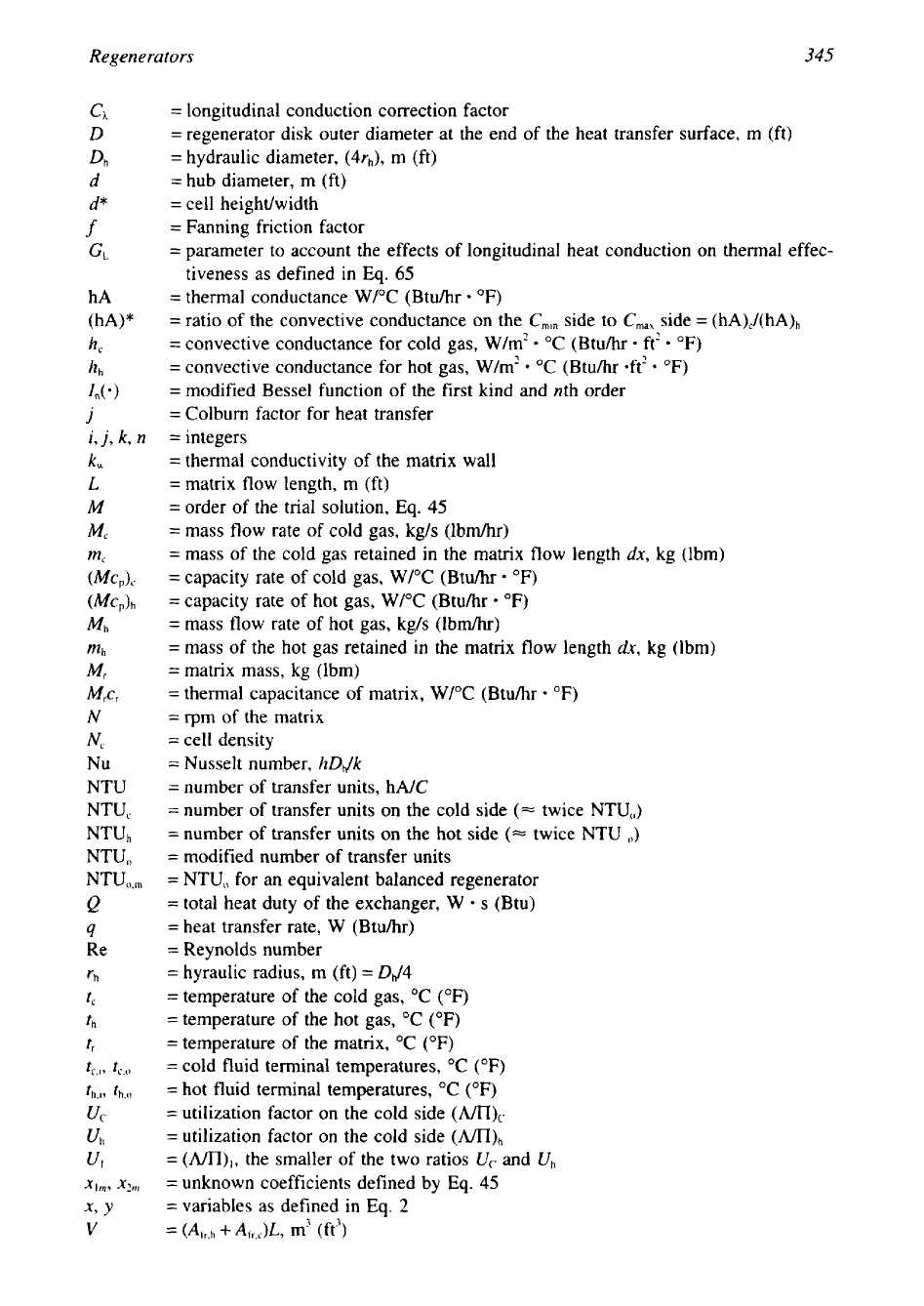
Regenerators
345
=
longitudinal conduction correction factor
=
regenerator disk outer diameter at the end of the heat transfer surface, m (ft)
=
hydraulic diameter, (4rh), m (ft)
=hub diameter, m (ft)
=
cell heighdwidth
=
Fanning friction factor
=
parameter to account the effects of longitudinal heat conduction on thermal effec-
tiveness as defined in Eq.
65
=
thermal conductance W/"C (Btu/hr
OF)
=
ratio of the convective conductance on the
C,,,
side to
C,,,
side
=
(hA)J(hA),
=
=
ft2 OF)
eft?
OF)
convective conductance for cold gas, W/m? "C (Btuh
convective conductance for hot gas, W/m? "C (Btu/hr
=
modified Bessel function of the first kind and nth order
=
Colburn factor for heat transfer
=
integers
=
thermal conductivity
of
the matrix wall
=
matrix flow length, m (ft)
=
order
of
the trial solution,
Eq.
45
=
mass flow rate
of
cold gas, kg/s (lbm/hr)
=
mass of the cold gas retained in the matrix flow length
dx,
kg (lbm)
=
capacity rate of cold gas, W/"C (Btu/hr
OF)
=
capacity rate of hot gas, W/"C (Btuhr OF)
=
mass flow rate of hot gas, kg/s (lbmkr)
=mass of the hot gas retained in the matrix flow length
dx,
kg (lbm)
=matrix mass, kg (lbm)
=
thermal capacitance of matrix, W/"C (Btu/hr
OF)
=
rpm of the matrix
=
cell density
=
Nusselt number, hDh/k
=
number of transfer units, hA/C
=
number of transfer units
on
the cold side
(==
twice NTUJ
=
number of transfer units on the hot side
(=
twice NTU
(,)
=
modified number of transfer units
=
NTU, for an equivalent balanced regenerator
=
total heat duty of the exchanger,
W
s
(Btu)
=
heat transfer rate, W (Btuh)
=
Reynolds number
=
hyraulic radius, m (ft)
=
&/4
=
temperature of the cold gas,
"C
(OF)
=
temperature of the hot gas, "C
(OF)
=
temperature of the matrix, "C (OF)
=
cold fluid terminal temperatures, OC
(OF)
=
hot fluid terminal temperatures, "C
(OF)
=
utilization factor on the cold side
("I),
=
utilization factor on the cold side (m)h
=
(Nn),,
the smaller of the two ratios
Uc
and
uh
=unknown coefficients defined by Eq.
45
=
variables as defined in
Eq.
2
=
(A1r.h
+
Afr.c)L, m3 (ft')
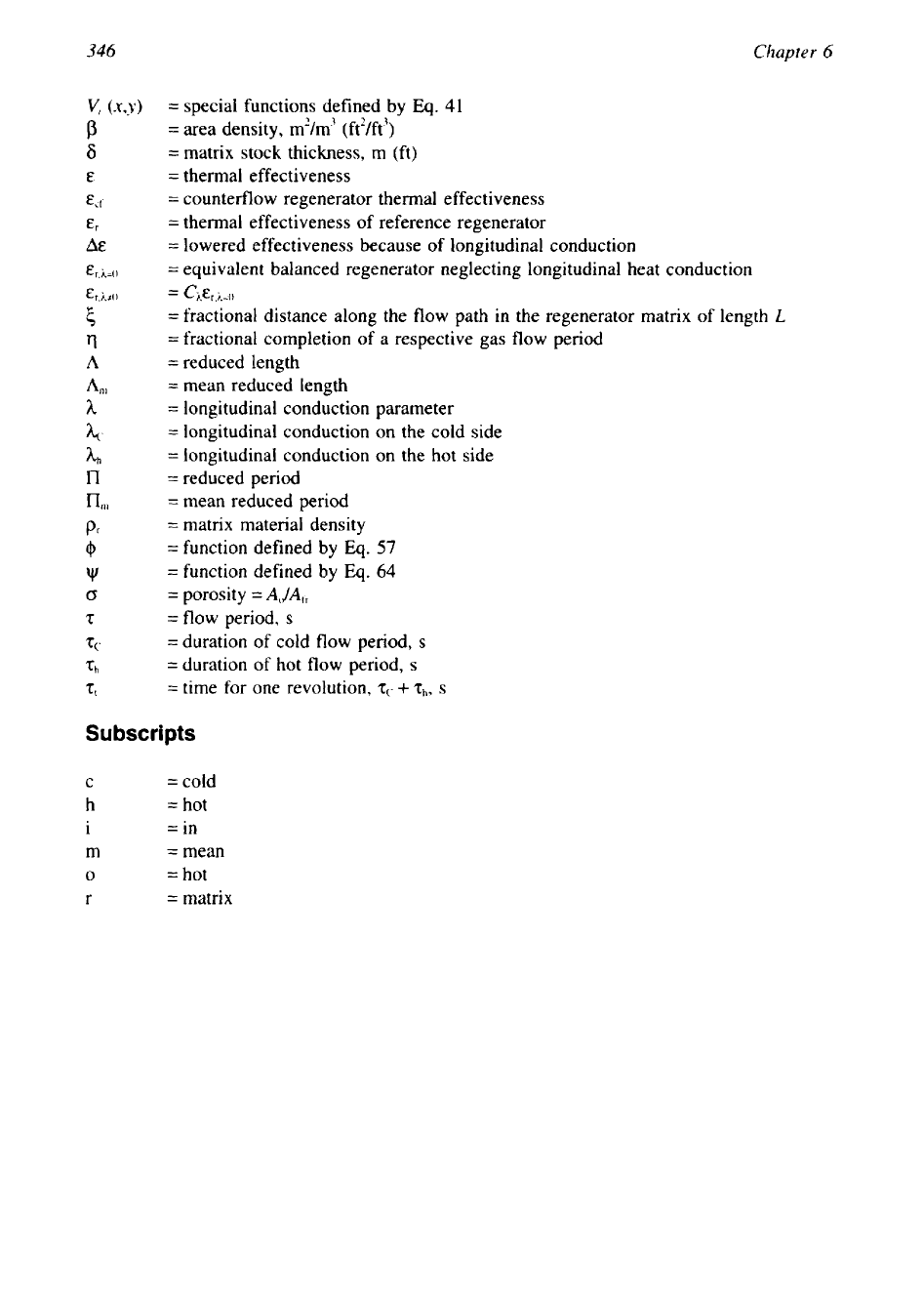
Chapter
6
=
special functions defined by
Eq.
41
=
area density, m2/m3 (ft2/ft7)
=
matrix stock thickness, m (ft)
=
thermal effectiveness
=
counterflow regenerator thermal effectiveness
=
thermal effectiveness of reference regenerator
=
lowered effectiveness because
of
longitudinal conduction
=
equivalent balanced regenerator neglecting longitudinal heat conduction
=
CAEr,E.=o
=
fractional distance along the flow path in the regenerator matrix of length
L
=
fractional completion
of
a respective gas flow period
=
reduced length
=
mean reduced length
=
longitudinal conduction parameter
=
longitudinal conduction on the cold side
=
longitudinal conduction on the hot side
=
reduced period
=
mean reduced period
=
matrix material density
=
function defined by
Eq.
57
=
function defined by
Eq.
64
=
porosity
=
AJA,,
=flow period,
s
=
duration of cold flow period,
s
=
duration of hot flow period,
s
=
time for one revolution,
zC
+
Th,
s
Subscripts
C
=
cold
h
=
hot
1
=
in
m
=
mean
0
=
hot
r
=
matrix
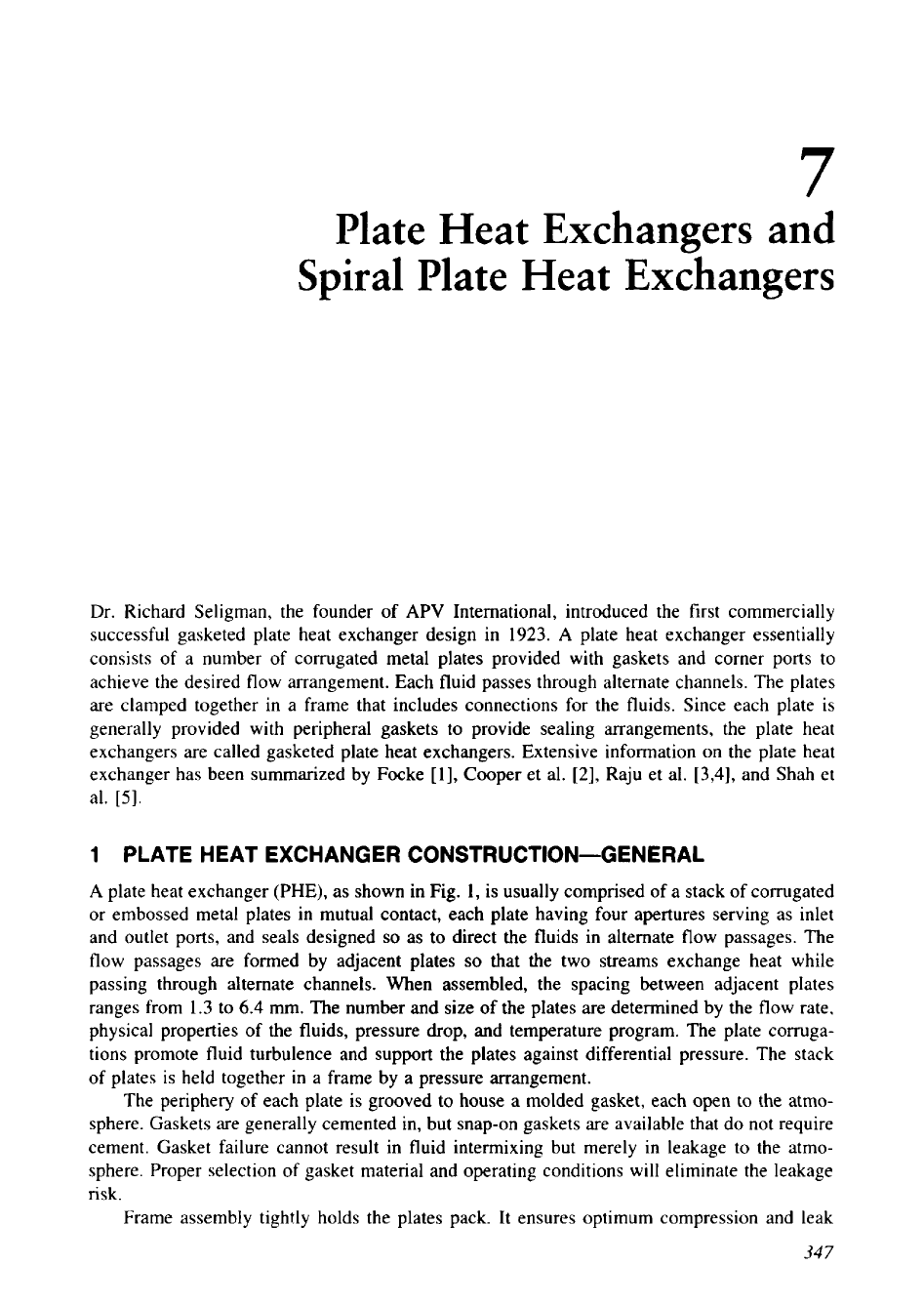
7
Plate Heat Exchangers and
Spiral Plate Heat Exchangers
Dr. Richard Seligman, the founder of
APV
International, introduced the first commercially
successful gasketed plate heat exchanger design in
1923.
A
plate heat exchanger essentially
consists of a number of corrugated metal plates provided with gaskets and corner ports to
achieve the desired flow arrangement. Each fluid passes through alternate channels. The plates
are clamped together in a frame that includes connections for the fluids. Since each plate is
generally provided with peripheral gaskets to provide sealing arrangements, the plate heat
exchangers are called gasketed plate heat exchangers. Extensive information on the plate heat
exchanger has been summarized by Focke
[l],
Cooper et al.
[2],
Raju et al.
[3,4],
and Shah et
al.
[5].
1
PLATE HEAT EXCHANGER CONSTRUCTION-GENERAL
A
plate heat exchanger
(PHE),
as shown in Fig.
1,
is usually comprised of a stack of corrugated
or embossed metal plates in mutual contact, each plate having four apertures serving as inlet
and outlet ports, and seals designed
so
as to direct the fluids in alternate flow passages. The
flow passages are formed by adjacent plates
so
that the two streams exchange heat while
passing through alternate channels. When assembled, the spacing between adjacent plates
ranges from
1.3
to
6.4
mm. The number and size
of
the plates are determined by the flow rate,
physical properties of the fluids, pressure drop, and temperature program. The plate corruga-
tions promote fluid turbulence and support the plates against differential pressure. The stack
of plates is held together in a frame by a pressure arrangement.
The periphery of each plate
is
grooved to house a molded gasket, each open to the atmo-
sphere. Gaskets are generally cemented in, but snap-on gaskets are available that do not require
cement. Gasket failure cannot result in fluid intermixing but merely
in
leakage to the atmo-
sphere. Proper selection of gasket material and operating conditions will eliminate the leakage
risk.
Frame assembly tightly holds the plates pack. It ensures optimum compression and leak
347
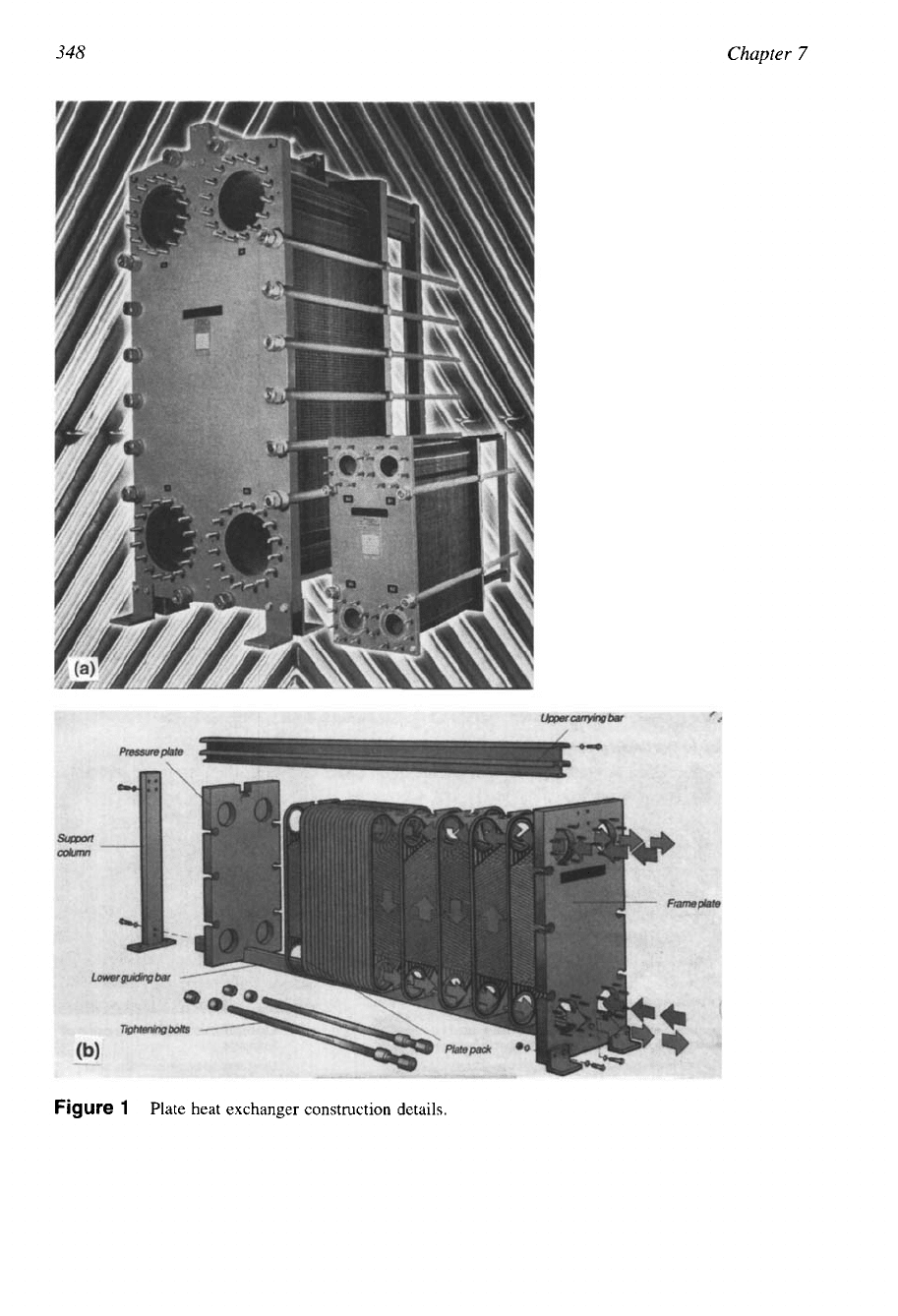
348
Chapter
7
Figure
1
Plate heat exchanger construction details.
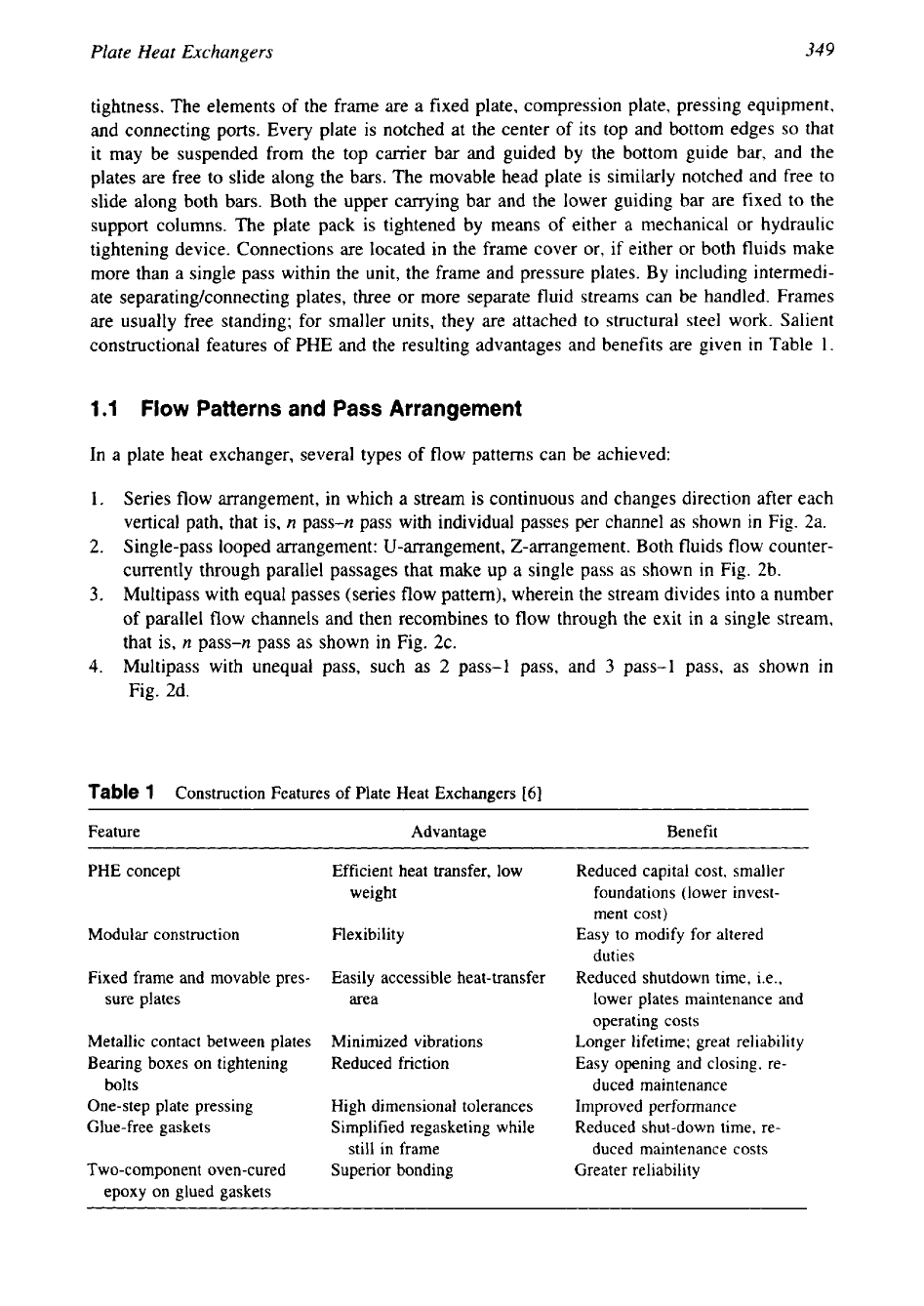
Plate Heat Exchangers
349
tightness. The elements of the frame are a fixed plate, compression plate, pressing equipment,
and connecting ports. Every plate is notched at the center of its top and bottom edges
so
that
it may be suspended from the top carrier bar and guided by the bottom guide bar, and the
plates are free to slide along the bars. The movable head plate is similarly notched and free to
slide along both bars. Both the upper carrying bar and the lower guiding bar are fixed to the
support columns. The plate pack is tightened by means of either a mechanical or hydraulic
tightening device. Connections are located in the frame cover or, if either or both fluids make
more than a single pass within the unit, the frame and pressure plates. By including intermedi-
ate separatingkonnecting plates, three or more separate fluid streams can be handled. Frames
are usually free standing; for smaller units, they are attached to structural steel work. Salient
constructional features of PHE and the resulting advantages and benefits are given in Table
1.
1.1
Flow
Patterns and Pass Arrangement
In a plate heat exchanger, several types of flow patterns can be achieved:
1.
Series flow arrangement, in which a stream is continuous and changes direction after each
vertical path, that is,
n
pass-n pass with individual passes per channel as shown in
Fig.
2a.
2.
Single-pass looped arrangement: U-arrangement, 2-arrangement. Both fluids flow counter-
currently through parallel passages that make up a single pass as shown in Fig. 2b.
3.
Multipass with equal passes (series flow pattern), wherein the stream divides into a number
of parallel flow channels and then recombines
to
flow through the exit in a single stream,
that is,
n
pass-n pass as shown in Fig. 2c.
4.
Multipass with unequal pass, such as
2
pass-1 pass, and
3
pass-1 pass, as shown in
Fig. 2d.
Table
1
Construction Features of Plate Heat Exchangers
[6]
Feature Advantage Benefit
PHE concept
Efficient heat transfer, low
Reduced capital cost, smaller
weight
foundations (lower invest-
ment cost)
Modular construction
Flexibility
Easy
to
modify for altered
duties
Fixed frame and movable pres-
Easily accessible heat-transfer
Reduced shutdown time, i.e.,
sure plates
area
lower plates maintenance and
operating costs
Metallic contact between plates
Minimized vibrations
Longer lifetime; great reliability
Bearing boxes on tightening
Reduced friction
Easy opening and closing, re-
bolts
duced maintenance
One-step plate pressing
High dimensional tolerances
Improved performance
Glue-free gaskets
Simplified regasketing while
Reduced shut-down time, re-
still in frame
duced maintenance costs
Two-component oven-cured
Superior bonding
Greater reliability
epoxy on glued gaskets

350
Chapter
7
4-
Figure
2
PHE
Flow arrangements.
(a)
Series flow
n
pass-n pass;
(b)
single pass looped:
U
arrangement
arrangement; (c) multipass with equal pass
(n
pass-n pass); and
(d)
multipass with unequal pass,
2
pass-1 pa
and
3
pass-1 pass.
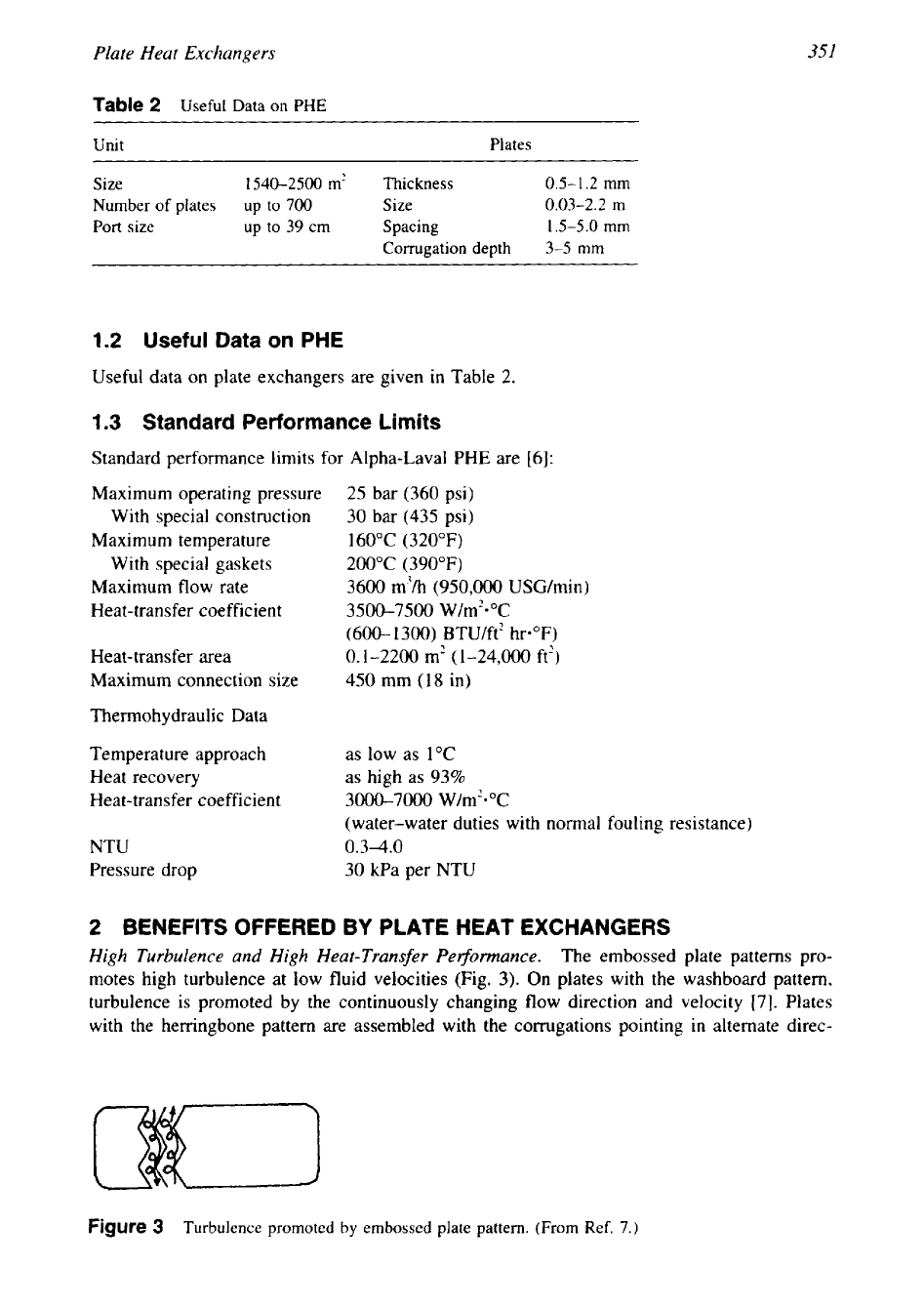
Plate Heat Exchangers
35
I
Table
2
Useful Data on
PHE
Unit Plates
Size
1540-2500 m'
Thickness
0.5-1.2
mm
Number of plates
up to
700
Size
0.03-2.2
m
Port
size up to 39 cm
Spacing
1.5-5.0
mm
Corrugation depth 3-5
mm
1.2
Useful Data on PHE
Useful data on plate exchangers are given in Table 2.
1.3
Standard Performance Limits
Standard performance limits for Alpha-Lava1 PHE are [6]:
Maximum operating pressure
25 bar (360 psi)
With special construction
30 bar (435 psi)
Maximum temperature
160°C (320°F)
With special gaskets
200°C (390°F)
Maximum flow rate
3600 m'/h (950,000 USG/min)
Heat-transfer coefficient
3500-7500 W/m'-"C
(600-1300) BTU/ft? hr*"F)
Heat-transfer area
0.1-2200
m'
(1-24,000 ft')
Maximum connection size
450
mm (1
8
in)
Thermohydraulic Data
Temperature approach
as low as 1°C
Heat recovery
as high as 93%
Heat-transfer coefficient
3000-7000 W/m'*"C
(water-water duties with normal fouling resistance)
NTU
0.3-4.0
Pressure drop
30 kPa per NTU
2
BENEFITS OFFERED
BY
PLATE HEAT EXCHANGERS
High Turbulence
and
High Heat-Transfer Per$ormance.
The embossed plate patterns pro-
motes high turbulence at low fluid velocities (Fig.
3).
On plates with the washboard pattern,
turbulence is promoted by the continuously changing flow direction and velocity [7]. Plates
with the herringbone pattern are assembled with the corrugations pointing in alternate direc-
Figure
3
Turbulence promoted by embossed plate pattern. (From Ref.
7.)
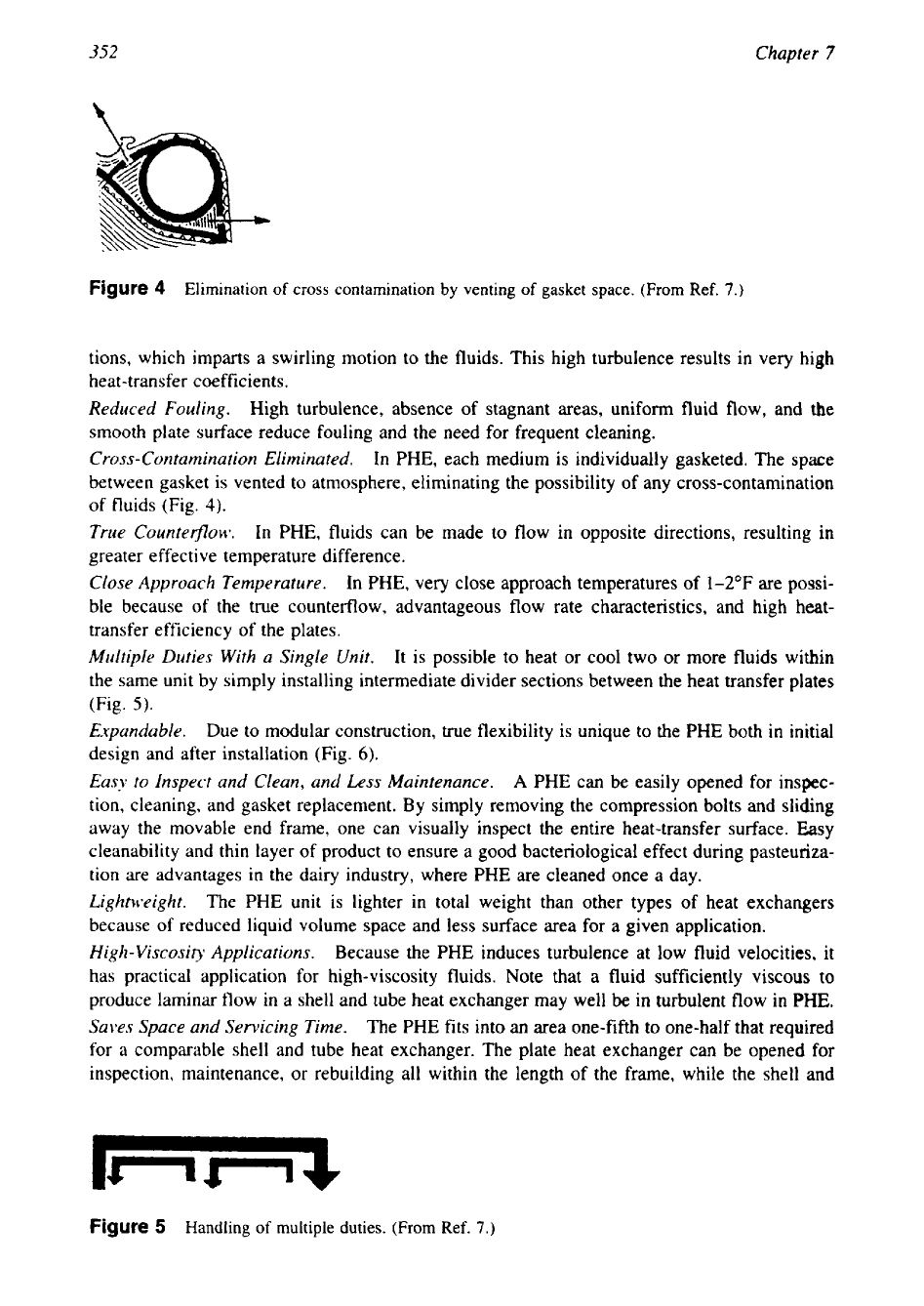
352
Chapter
7
Figure
4
Elimination of cross contamination
by
venting
of
gasket space. (From
Ref.
7.)
tions, which imparts a swirling motion to the fluids. This high turbulence results in very high
heat-transfer coefficients.
Reduced
Fouling.
High turbulence, absence of stagnant areas, uniform fluid flow, and the
smooth plate surface reduce fouling and the need for frequent cleaning.
Cross-Contamination Eliminated.
In PHE, each medium is individually gasketed. The space
between gasket
is
vented
to
atmosphere, eliminating the possibility of any cross-contamination
of fluids (Fig.
4).
True Counteflow.
In PHE, fluids can be made to flow in opposite directions, resulting in
greater effective temperature difference.
Close
Approach Temperature.
In
PHE,
very close approach temperatures of
1-2°F
are possi-
ble because of the true counterflow, advantageous flow rate characteristics, and high heat-
transfer efficiency of the plates.
Multiple Duties With a Single Unit.
It is possible to heat or cool two or more fluids within
the same unit by simply installing intermediate divider sections between the heat transfer plates
(Fig.
5).
Expandable.
Due to modular construction, true flexibility is unique to the PHE both in initial
design
and
after installation (Fig.
6).
Easy to Inspect and Clean, and
Less
Maintenance.
A
PHE can be easily opened for inspec-
tion, cleaning, and gasket replacement. By simply removing the compression bolts and sliding
away the movable end frame, one can visually inspect the entire heat-transfer surface.
Easy
cleanability and thin layer of product to ensure a good bacteriological effect during pasteuriza-
tion are advantages in the dairy industry, where PHE are cleaned once a day.
Lightweight.
The PHE unit is lighter in total weight than other types of heat exchangers
because of reduced liquid volume space and less surface area for a given application.
High- Viscosity Applications,
Because the PHE induces turbulence at low fluid velocities, it
has practical application for high-viscosity fluids. Note that a fluid sufficiently viscous to
produce laminar flow in a shell and tube heat exchanger may well
be
in turbulent flow in
PHE.
Saves Space and Servicing Time.
The PHE fits into an area one-fifth to one-half that required
for a comparable shell and tube heat exchanger. The plate heat exchanger can be opened for
inspection, maintenance, or rebuilding all within the length of the frame, while the shell and
Figure
5
Handling of multiple duties.
(From
Ref.
7.)

353
Plate Heat Exchangers
Figure
6
Flexibility
to
expand. (From Ref.
7.)
tube heat exchanger with removable tube bundle requires double its length to remove the tube
bundle.
Less
Operational Problems.
In plate heat exchangers, flow-induced vibration, noise, and ero-
sion-corrosion due to impingement attack are not present as in shell and tube heat exchangers.
Lower
Cost.
Plate heat exchangers are generally more economical than other types of equiva-
lent duty heat exchangers, due to the higher thermal efficiency and lower manufacturing costs
of
plate heat exchangers.
Quick Process Control.
Owing to the thin channels created between the two adjacent plates,
the volume of fluid contained in PHE is small; it quickly reacts to the new process condition
and is thereby easier to control.
3
COMPARISON BETWEEN
A
PLATE HEAT EXCHANGER AND
A
SHELL AND TUBE HEAT EXCHANGER
In many cases the plate heat exchanger has replaced the shell and tube exchanger (STHE) for
services within the latter’s operational limits. For identical duties (liquid-liquid service) and in
those cases when the working limits of the gaskets are not exceeded, the merits of the PHE
over the STHE are given in Table
3.
4
PLATE HEAT EXCHANGER-DETAILED
CONSTRUCTION FEATURES
With a brief discussion
of
PHE construction, additional construction features and materials of
construction for components such as plates, gaskets, frame, and connectors are discussed next.
4.1
Plate
Plate Pattern
Plates are available in a variety of corrugated or embossed patterns. The basic objective of
providing corrugation to the plates is to impart high turbulence to the fluids, which results in
a
very high heat-transfer coefficient compared to those obtainable in a shell and tube heat
exchanger for similar duties. These embossing patterns also result in increased effective surface
areas and provide additional strength to the plates by means of many contact points over the
plates to withstand differential pressure that exists between the adjacent plates. Plate thickness
as low as
0.6
mm
(0.024
in) can therefore be used for working pressures as high as
230
psig,
particularly when using the cross-corrugated, herringbone pattern
[8].
Types of Plate Corrugation
Over
60
different plate patterns have been developed worldwide. The pattern and geometry
are proprietary. The most widely used corrugation types are the
intermating troughs
or
wash-
